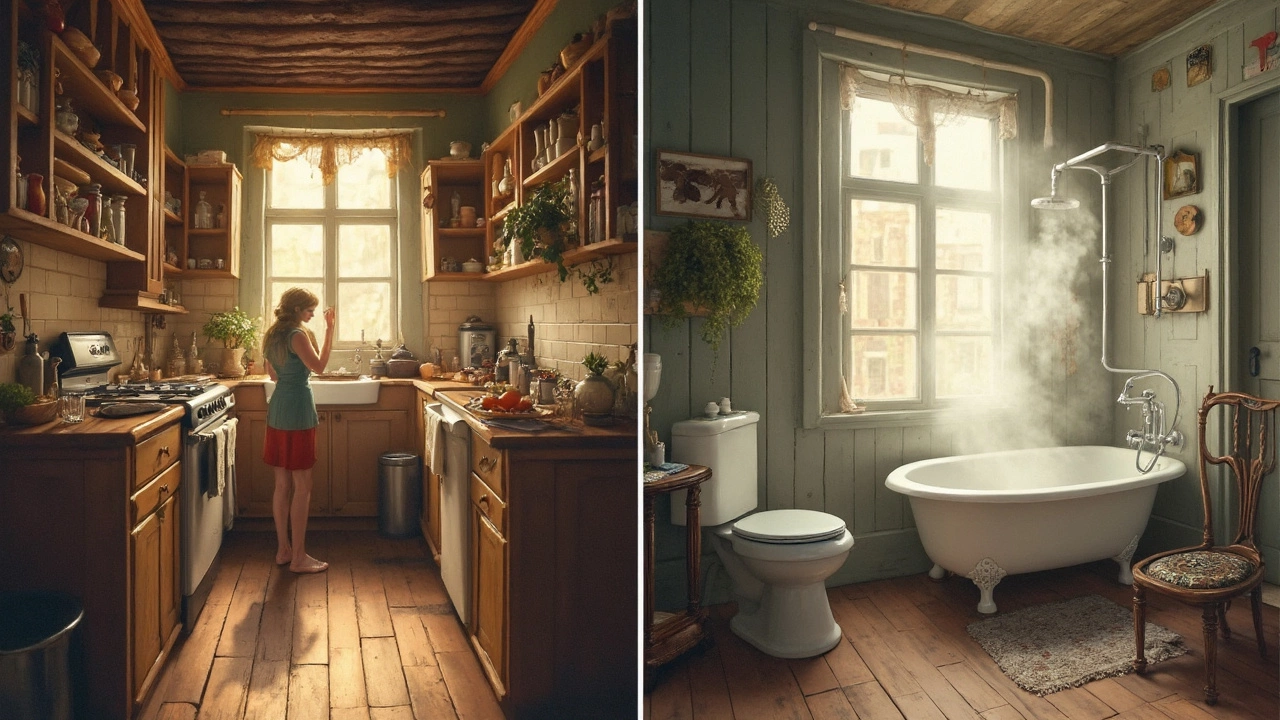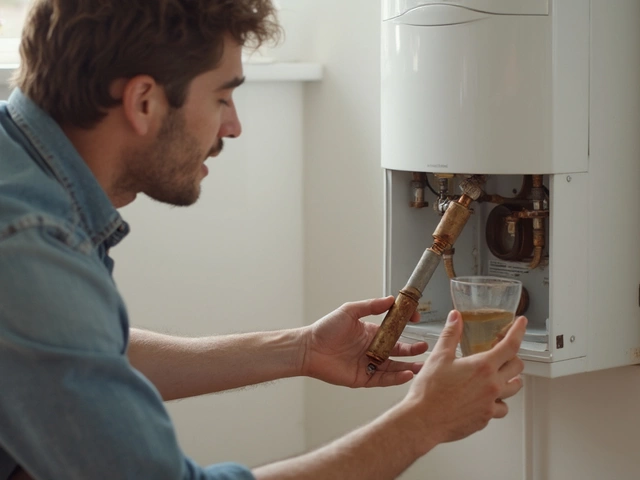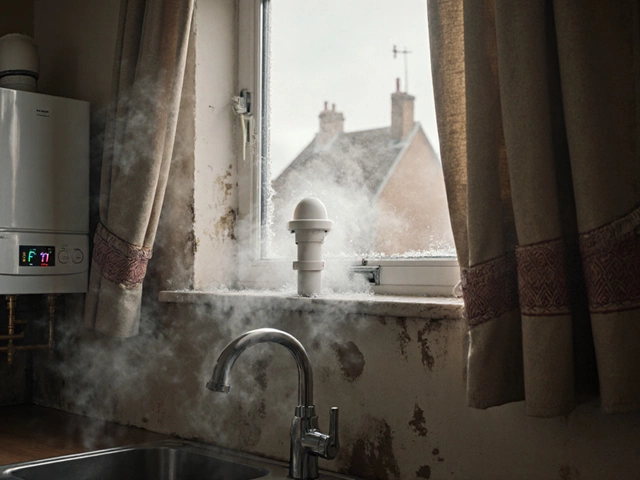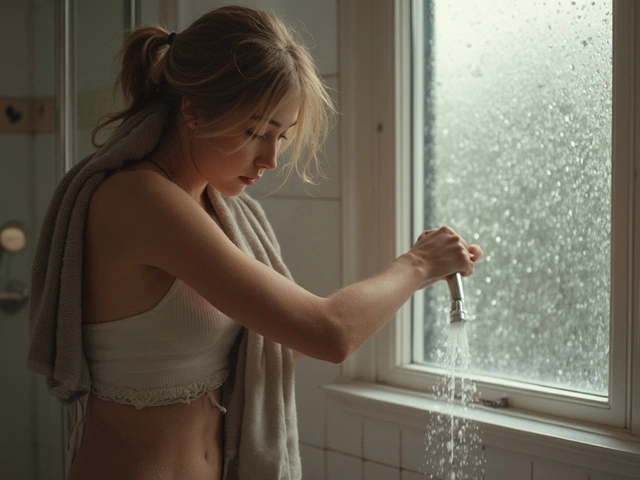Ever wonder why your kitchen faucet pours out steamy water while your bathroom leaves you shivering? It's more common than you might think. Let's first understand your home's water system. Essentially, your water heater is the big boss, determining where the hot water goes—kitchen, bathroom, you name it. But sometimes, things don’t flow as expected.
One simple explanation could be the distance between your water heater and the bathroom compared to the kitchen. The farther the hot water has to travel, the cooler it might become by the time it reaches the tap. But that’s not all—clogged pipes or faulty fixtures can also throw a wrench in the works.
Think it might be a plumbing issue or something wrong with the water heater itself? Before you reach for the phone, there are a few things you might want to check out. Stay tuned for some troubleshooting tips that could help you dodge that service fee.
- Understanding Your Water System
- Common Causes for Hot Water Issues
- Plumbing Layout and Its Impact
- DIY Troubleshooting Tips
- When to Call a Professional
- Preventative Measures for the Future
Understanding Your Water System
Diving into the plumbing wizards of your home might feel like stepping into an unknown world, but it's pretty straightforward when you break it down. The heart of it all is your water heater. This machine is crucial for creating the hot water that flows to your kitchen and bathroom.
Water heaters typically come in two main types: tank and tankless. Most homes use tank-style heaters, where water is heated and stored in a big tank until you need it. Tankless systems, however, heat the water on demand. Both have their pros and cons, but they essentially serve the same purpose—providing hot water when needed.
Home Plumbing Configuration
How does water travel from the heater to your taps? Well, it starts with a main line that branches out to serve different parts of your house. Your kitchen and bathroom each have their own lines connected to a primary hot water line.
Distance plays a huge role here. If your bathroom is located further from the heater than the kitchen, the water naturally loses some of its heat during the journey. Insulation can help, but we'll touch on that later.
Hot Water Circulation
Some homes have a hot water recirculation system. This keeps hot water constantly moving through the pipes, reducing wait time. It's great if you're tired of running the tap for ages, warming your bathroom against freezing blasts, but not everyone has this setup.
When issues arise, it’s often because of how your home’s plumbing is laid out or how the water heater is functioning. Knowing the water paths can guide where troubleshooting efforts should begin. Remember, a well-understood system is easier and cheaper to fix.
Common Causes for Hot Water Issues
Understanding why your bathroom is lacking that much-needed warmth while the kitchen isn't involves diving into some typical problem areas. First up, have you considered the condition of your plumbing system? Over time, pipes can get clogged with minerals, especially in areas with hard water. This might slow down the flow or even block it, leading to inconsistent temperatures.
Distance from the Water Heater
How far is your bathroom from the water heater? The longer the piping, the more heat it can lose on the journey. This is super common, especially in older homes where water heaters might sit in awkward, distant corners of the house.
Issues with the Water Heater
Your trusty water heater might not be operating at full capacity. If it's older, or if there's an issue with the heating element or thermostat, it may not heat the water sufficiently or consistently. This is a clear sign that maybe it's time for a repair or even a replacement.
Faulty Fixtures
Old or broken fixtures can also contribute. If your faucet or showerhead is malfunctioning, it might not mix the hot and cold water properly. Sometimes, these fixtures develop leaks or blockages that impact the water temperature.
Quick Stats
Did you know that approximately 15% of all household water heating issues stem from blocked pipes? And about 25% are due to aging water heaters that underperform during high-demand periods.
Recognizing these common causes can help you pinpoint the issue faster and get back to enjoying those much-loved hot showers!
Plumbing Layout and Its Impact
The layout of your home's plumbing can play a big role in why your hot water works in the kitchen but not as well in the bathroom. It’s not just about distance—though that’s a major piece of the puzzle.
Distance and Heat Loss
One fact to consider is that heat can be lost as hot water travels through your pipes. If your bathroom is on the other side of the house from the water heater, it has more time to cool down before reaching the faucet. It’s like you and your coffee—even a short walk can cool down that steaming cup.
Piping Material Matters
Different piping materials can also affect temperature retention. Copper pipes, while durable, might lose heat quicker than PEX pipes because of their conductive properties. A wise guy once said, “The best insulation is minimal distance”—and in plumbing, it holds water literally.
Old Vs. New Plumbing
"Older plumbing systems can lead to uneven hot water distribution through worn-out pipes and outdated routing," remarked Jake Foster, a veteran plumber with over 30 years of experience.
In older homes, the plumbing might not have been updated to accommodate new layouts and appliances, leading to inefficiencies that can be fixed with modern retrofitting.
How Can You Address This?
- Evaluate Pipe Insulation: Insulate your pipes to help retain heat and reduce energy loss.
- Consider a Recirculating System: These systems help deliver hot water quicker and more reliably to all taps.
- Check Pipe Size: Sometimes, the diameter of pipes can impact flow and pressure, affecting temperature delivery.
Fixing these layout issues can sometimes require a bigger overhaul than simple DIY tasks. Consulting a plumber can offer insights that save both time and future headaches in your quest for balanced hot water across the home.
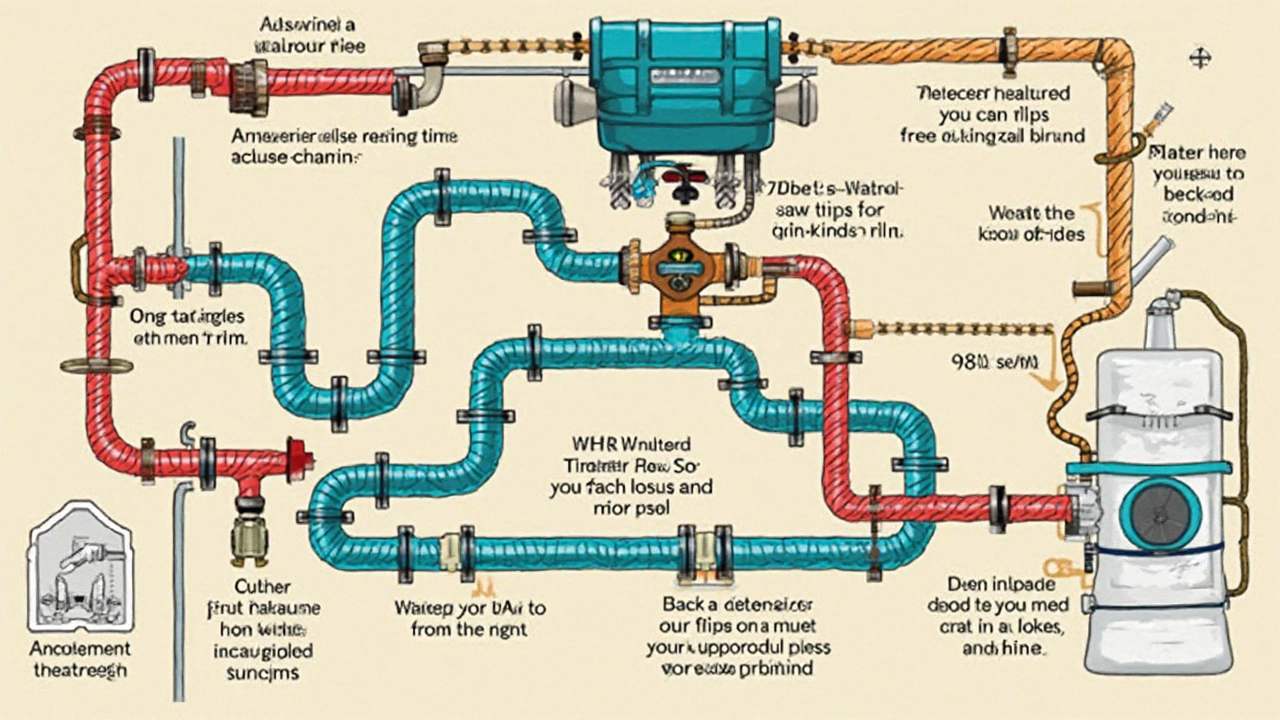
DIY Troubleshooting Tips
Alright, let’s get hands-on about figuring out why your hot water isn't cooperating at both faucets. No need to call a pro just yet; try these simple checks first.
Check the Temperature Setting
Start with a quick peek at your water heater's temperature setting. Ideally, it should be around 120 degrees Fahrenheit. Anything lower might not cut it for the bathroom and kitchen simultaneously. Adjust if necessary, but don’t crank it too high—you don’t want scalding water either!
Inspect for Clogs
Next up, check for clogs that could be blocking hot water flow. A blocked pipe or a half-open valve might be the bad guy here. Go faucet-by-faucet:
- Turn off the water supply to the faucet.
- Remove the faucet aerator and check for mineral buildup.
- Clean or replace if you see gunk stuck in there.
Repeat this for both kitchen and bathroom fixtures. You’d be surprised how often this little job makes a big difference!
Check Pipe Insulation
Insulation might sound fancy, but it helps keep the hot water hot as it travels through pipes. If there’s not enough insulation or it's deteriorated, that heat could disappear fast. Wrap some pipe insulation around the exposed areas; it’s cheap and effective.
Water Usage Schedule
Lastly, consider your water usage patterns. Running multiple hot water-heavy tasks at once can throttle your supply. Try staggering dishwashing, laundry, and showers to give your water heater a fighting chance.
Still Stumped?
If these fixes don’t solve the issue, it might be time to call a plumbing issue expert. But hey, at least now you can speak their language when they walk through the door!
| Potential Issue | Quick Fix | Time Required |
|---|---|---|
| Temperature Setting | Adjust Heater Thermostat | 5 minutes |
| Clogged Fixtures | Clean Aerators | 15 minutes |
| Pipe Insulation | Add Insulation | 30 minutes |
When to Call a Professional
Sometimes, despite your best efforts, you just can’t crack the problem. That’s when a professional plumber comes to the rescue. But how do you know it’s time to make that call? Well, here’s what to look out for.
Persistent Hot Water Problems
If your hot water is being stubborn no matter what you try, it's a sign you need expert attention. Persistent issues could mean something serious like a malfunctioning water heater or major plumbing issues that you can’t fix on your own.
Strange Noises or Smells
Unusual noises or a rotten egg smell coming from your water heater or pipes could indicate bigger issues. These often hint at sediment build-up, a failing heater, or even gas leaks, which require professional handling pronto.
Water Leakage
Leaks anywhere in your water system can lead to costly damage if not addressed quickly. A pro can efficiently locate and repair the source of the leak.
Frequent Temperature Fluctuations
If your water temperature is as inconsistent as a Wi-Fi connection in an old building, it’s time to get someone who knows what they're doing. This might be a sign of a water heater thermostat issue or a problem with the mixing valves that keep things stable.
Cost vs. DIY
It might be tempting to tackle everything yourself, but complex problems can get pricey if handled poorly. Pros come with guarantees and insurance that protect you from additional expenses down the line.
| Issue | Repair Cost |
|---|---|
| Water Heater Replacement | $500 - $1,000 |
| Pipe Leak Repair | $150 - $350 |
| Thermostat Fix | $100 - $300 |
Remember, when in doubt, give the experts a shout. They’re equipped with the tools and experience to get you back to those hot, relaxing showers you deserve.
Preventative Measures for the Future
Alright, let’s talk about keeping your hot water flowing smoothly both in the kitchen and bathroom. A few simple steps can help you avoid those cold surprises down the road.
Routine Maintenance
First things first, regular water heater repair and maintenance can save you a ton of headaches. Experts recommend flushing your water heater once a year to remove sediment buildup, which can hinder performance. It’s a simple process but, if you're unsure, it's best to call in a pro.
Check Your Pipes
Make it a habit to check your plumbing for leaks or corrosion. A quick glance under the sink might catch a small issue before it becomes a big problem. Insulation is key, too. Adding pipe insulation, especially on pipes running through unheated areas, can help maintain that hot water temp, ensuring your bathroom isn’t left in the cold.
Upgrade When Necessary
If your water heater is over a decade old, consider upgrading to a more efficient model. Modern heaters not only do a better job at supplying hot water evenly but can also reduce energy costs. Tankless or on-demand models are worth a look if you want consistent hot water without the wait.
Consult a Professional
When in doubt, get a professional opinion. An experienced plumber can assess your home’s plumbing layout and give tailored advice. Remember, sometimes what seems like a minor plumbing issue can indicate a deeper problem that needs expert attention.
Keeping Track
Here’s a simple table to keep track of maintenance:
| Task | Frequency | Notes |
|---|---|---|
| Flush Water Heater | Annually | Removes sediment |
| Inspect Pipes | Biannually | Check for leaks & insulation |
| Upgrade Water Heater | Every 10-15 years | Consider energy-efficient models |
With these preventative measures, you’re not just fixing today's problem but gearing up for a trouble-free future. So, take a proactive approach, and let your hot water woes be a thing of the past!

